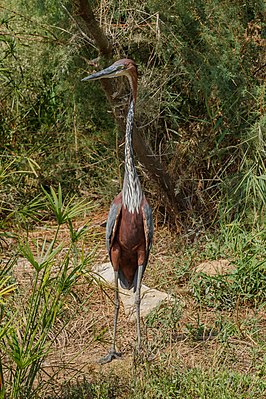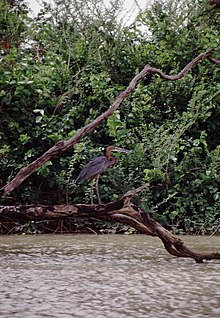Goliath Heron
| Goliath Heron | ||||||||||||
|---|---|---|---|---|---|---|---|---|---|---|---|---|

Goliath heron ( ardea goliath ) |
||||||||||||
| Systematics | ||||||||||||
|
||||||||||||
| Scientific name | ||||||||||||
| Ardea goliath | ||||||||||||
| Cretzschmar , 1829 |

The goliath heron ( Ardea goliath ) is a bird art from the family of herons in the order Pelecaniformes . With a height of 135 to 150 centimeters, it is the largest recent heron in the world. It therefore also hunts in deeper waters than the species related to it. Its distribution area today is predominantly Africa. However, there still appears to be a small residual population in Southeast Asia.
The Goliath heron is considered to be a close relative of the two Asian species Imperial and Black Heron .
Appearance
The Goliath Heron can grow up to 150 centimeters. It weighs between 4,300 and 4,468 grams. The head is reddish maroon and has elongated feathers at the back of the head that form a small tuft. The beak is very long and thick. The upper bill is blackish, the lower bill, however, horn-colored. The chin and throat are white with black stripes that extend down the neck to the upper chest. The back and the wing covers are slate gray. A red-brown shoulder spot can also be seen in upright birds. The white feathers of the upper breast are elongated in a lanceolate shape and hang down over the red-brown breast spot. The legs are very long and blackish in color.
Young birds are similar to adult birds. The chestnut-brown body parts are a bit paler with them.
voice
The calls of the Goliath heron can be heard up to a distance of two kilometers. The call is circumscribed onomatopoeically with kowoork . It usually sounds several times in a row. The calls of individual individuals are distinguishable. Goliath herons, startled, call out a sharp arrk .
Distribution area and habitat
The range of the Goliath heron includes southern and eastern Africa as well as small peripheral areas of the Arabian Peninsula. He used to breed in Iraq, Syria and Iran, southern Jordan and Israel; However, there are no more current breeding records for these regions. Occasionally it is also observed in the Sundarbans in Bangladesh and in Assam in India. Due to the great distance from today's main distribution area, it is assumed that there are still small residual populations in India and Bangladesh that are not documented.
It is still common in the East African wetlands. In the rest of East and South Africa it is a widespread, but numerically infrequent species. The population for Tanzania, for example, is estimated at 2,500 to 4,000 birds. In South Africa he benefits from the installation of cattle troughs, water reservoirs and dams. Here its spread has increased.
Its habitat includes extensive areas of shallow water both on the coast and inland. The Goliath heron is considered to be a species of heron that is particularly bound to the water and rarely moves far from the water.
Food and subsistence
The Goliath Heron normally looks for its food alone and defends its food territory from other conspecifics. It usually looks for its food at dusk and occasionally during the night. When looking for food, he slowly steps from the shore zone deeper and deeper into the water. He always pauses for a very long time and waits for prey to get within his reach. If prey comes closer, it is grabbed with a quick movement of the head and neck. Its diet consists entirely of fish. It is able to capture and eat fish weighing two to three kilograms. Some of its prey is often stolen from it by other fish-eaters. These include ospreys and pelicans , but also the saddle stork .
Reproduction
The beginning of the breeding season coincides in many parts of its range with the onset of the rainy season. In some regions of its range, however, it also breeds all year round without a seasonal pattern being discernible. Goliath herons breed on the ground. They prefer islets surrounded by water or dense vegetation zones in the water as nesting sites. It has been observed several times that Goliath herons give up their nests when a connection to the mainland is established due to falling water levels. Occasionally their nest is found in a loose colony with alien birds such as ibises, cormorants, other herons or gulls. Colonies with conspecifics also occur, however, and there is evidence that nesting success in such colonies is higher than in individually breeding birds.
Their nest has a diameter of up to one meter and is made of reeds and twigs in the reed belt or between low bushes standing by the water. The female lays around two to three light blue eggs, which are incubated by both parent birds for four weeks. The young fledge at six weeks of age.
literature
- James A. Kushlan & James A. Hancock: Herons . Oxford University Press, 2005, ISBN 0-19-854981-4
Web links
- Ardea goliath in the endangered Red List species the IUCN 2008. Posted by: BirdLife International, 2008. Accessed January 2 of 2009.
- Videos, photos and sound recordings of Ardea goliath in the Internet Bird Collection

